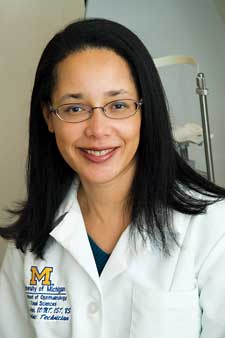There often were times when longtime professional dancer Cynthia Abejuro would be the only Hispanic and/or African-American performer in the room.

“Through dance I have been accepted into different cultures,” says Abejuro, lead technician for neuro-ophthalmology and plastics and reconstruction at the Kellogg Eye Center. “I feel blessed to experience these cultures that other Westerners have not.”
Her professional dance experience includes work with the Bikurim Israeli Folk Ensemble, Maria Del Carmen Grupo Espana and Nadanta, an East Indian group.
“What makes my experiences more interesting is that I have a Black and Hispanic ethnic background,” Abejuro says. “But I never felt different from other dancers,” she says. On the contrary, the creative arts have allowed Abejuro to navigate through various social, cultural and ethnic groups.
“Ever since I was a girl all I wanted to do was dance,” Abejuro explains. She continued to dance as she obtained her bachelor’s degree in ophthalmic technology from Wayne State University, and was one of only 12 students to graduate from that program.
Abejuro today has 25 years experience as an ophthalmic technician. Her everyday assignments in her position at Kellogg Eye Center include preoperative evaluation of cosmetic and reconstructive surgeries and trauma cases along with postoperative care and some surgical procedures. She also manages technicians. “I was amazed at how knowledgeable and skilled my coworkers were when I started in the neuro/plastics (department) five years ago,” she says. “I feel very fortunate to work in such an atmosphere.”
Abejuro also feels fortunate for how she has benefited from her 30 years of dance studies. She started with traditional ballet and jazz dance before exploring international dance. One international dance tradition that Abejuro became deeply involved in was East Indian dance, where tradition calls for a dancer to perform a three-hour solo recital followed by a reception.
Abejuro says these events are almost like wedding receptions in importance as well as scope. As she participated, her parents often were invited.
“During one of the receptions, the mother of another dancer even told my parents that I was an inspiration for their daughters,” she recalls.
As a teenager, she was invited to study at the International Cecchetti Council of America summer school, and went on to explore a range of dance forms. “Each time I was accepted into a new dance group, it was because that dance director saw me dancing somewhere else,” says Abejuro, “and through someone we both knew, contacted me.”
At times Abejuro was the dancer receiving the most public attention. During these moments, she says her colleagues always remained proud. “I was often the one photographed with (different dance) groups while other girls were excluded,” Abejuro recalls. “But the mothers of these dancers were just as proud of me as they would have been with their daughters.”
Abejuro recently took a three-year retirement from dance to care for her aging parents. She has begun performing again with the group Alma Espanola at Vicente’s Cuban Cuisine in Detroit and TuCan Tango in West Bloomfield. Her current performance is of flamenco and classical Spanish dance styles.
“This is actually the dance form that I’ve had the most exposure to,” Abejuro explains. “When I started in flamenco, it was extremely rare for non-Spanish and even Hispanics to be involved in flamenco, much less someone who was African American.
“It’s almost like starting over at the beginning, trying to obtain the previous technical excellence,” Abejuro says, adding she’s glad to be back on her feet.

